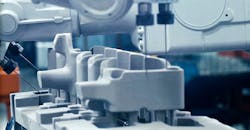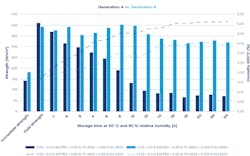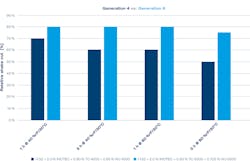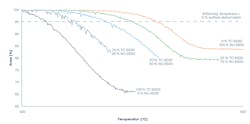Inorganic Binder Systems with High Moisture Stability
Metalcasters worldwide recognize ASK Chemicals' INOTEC technology as an environmentally friendly and highly productive core manufacturing process for producing light metal castings. Using these thermosetting, inorganic binder systems in high-volume automotive applications prevents emissions during core production, core storage and casting. In addition, the value chain in aluminum low-pressure diecasting and gravity casting processes can make use of its economic and technological advantages, as no condensates are produced from the pyrolysis of the binder system. This generates additional degrees of freedom for temperature control in the casting process.
The faster solidification can result in cast aluminum components with improved metal microstructure. In addition, cleaning and maintenance requirements for the permanent molds are reduced, increasing mold availability and thus productivity.
Until now, inorganic binder systems have been used mainly to produce cylinder heads and crankcases for internal combustion engines. In the course of the diversification of the powertrain in the automotive industry, new fields of application have emerged, so that today central housings for electric motors and structural components (subframes, axle carriers) also are produced with inorganic binder systems.
Thus, INOTEC technology has evolved from a specialty formulation to a diversely applicable binder system in core production. Specific sand core properties – such as moisture stability, shakeout properties, and thermal stability – remain central parameters for inorganic binder system performance.
The moisture stability (also called storage stability) of inorganic-bonded sand cores generally describes the stability of the binder system against absolute humidity during core storage. In case of insufficient moisture stability, cracking of the sand core up to core breakage may occur during storage. Uncontrolled absorption of (air) moisture results in an increased gas potential of the inorganic-bonded sand core, so that gas inclusions can remain in the aluminum casting component during the casting processes.
After casting, the behavior of the inorganically bonded sand cores with respect to absolute humidity influences the shakeout property during raw part processing. If moisture stability is insufficient, reactivation of the binder system may occur and an increase in strength or reduced shakeout behavior can be observed. Thus, the moisture stability of inorganic binder systems is a key performance indicator for the entire process chain of casting production, especially for filigree and complex sand core geometries, such as water jackets for cylinder heads and electric motors.
Usually, the moisture stability of inorganic binder systems is controlled by adding lithium salts in the liquid binder. However, this results in lower cold strengths as entry value for the core storage, so that comparatively higher addition rates of liquid binder are necessary to obtain a suitable strength level. At the same time, lithium salts in particular cannot be used economically due to the high demand from the battery industry.
The sixth generation of INOTEC promoters improves the moisture stability of inorganic-bound sand cores as a key performance characteristic of the solid binder system component. The moisture stability of inorganically bonded sand cores can be monitored by determining the strength and moisture content during core storage at high absolute humidity. Measuring the moisture at 600 °C is necessary in order to record the sum of absorbed water in the sand core. Figure 1 shows the development of the two parameters – "Strength" (bars and left scale) and "Humidity 600 °C" (dashed lines and right scale) – of promoter formulations of the fourth and sixth generation as a function of storage time at an absolute humidity of approximately 18 g water/m3 air (30 °C, 60% relative humidity.)A standardized test specimen (bending bar) exhibits a cold strength of 375–400 N/cm2 and a moisture content (600 °C) of about 0.20% one hour after core production, regardless of the promoter generation used . For the fourth generation of INOTEC promoters, the strength already decreases continuously at the beginning of the storage process. The half-life of the cold strength is already reached after a storage time of 8 hours.
At the same time, a strong increase in the moisture content of the sand core can be seen, amounting to 0.40% after a storage period of 8 hours. In contrast, the sixth generation promoter shows a constant strength level up to a storage time of 10 hours, and a reduced moisture absorption of 0.30%. Only in the further course of the storage period does a decrease in strength become apparent.
Nevertheless the strength retention within the storage period of 24 hours is approximately 82% of the cold strength. The moisture content determined at 600 °C is then 0.35%. Both parameters demonstrate the improved moisture stability of the sixth promoter generation. In addition to this improved moisture stability during core storage, the use of the sixth-generation promoter also leads to improved process stability during raw part machining.
Figure 2 shows the shakeout property of a standardized test specimen (bending bar) based on the fourth- and sixth-generation promoters when the raw castings are stored at different humidity levels. The specimens were thermally stressed at 650 °C, stored accordingly at different climatic conditions, and the shakeout property was determined after mechanical impact. The shakeout behavior of inorganically bonded sand cores based on the fourth-generation promoter is negatively affected with increasing storage time and higher absolute humidity. In contrast, the shakeout property of inorganic-bound sand cores based on the sixth-generation promoter remains constant.The concept of thermal stability has been incorporated in the sixth-generation INOTEC promoters through the proven tooling concept. Thermal stability describes the resistance of the binder system to mechanical and thermal influences of casting applications. In this context, the INOTEC WJ 6500 promoter exhibits exceptionally high thermal stability, which counteracts deformation especially of filigree and thermally stressed core geometries, such as water jacket cores, during casting applications.
In contrast, the INOTEC TC 6500 promoter has low thermal stability and is suitable for producing voluminous core geometries. The complementary product formulations can be mixed in any ratio, so that a specific thermal stability can be set depending on the sand core geometry. The effect of different mixing ratios of the INOTEC promoters TC 6500 and WJ 6500 on the binder system’s thermal stability can be observed, for example, with a heating microscope (see Figure 3.) The change in area of a cubic test specimen consisting of INOTEC binder and INOTEC promoter is recorded with increasing temperature. A change in area of 5% is defined as the so-called softening temperature, so that conclusions can be drawn about the incipient softening of the binder system from the curve progression. The successive increase in the application rate of the thermostable INOTEC promoter WJ 6500 leads to an increase in thermal stability, recognizable by the increasing softening temperature.In addition to these sand core-specific properties, a reduced addition rate for sixth-generation promoters and thus increased material efficiency should also be highlighted. When using the product formulation alone, addition rates are reduced by 31% (TC 6500) and 24% (WJ 6500) compared to fourth-generation promoters.
In summary, the sixth-generation INOTEC promoter system offers optimized moisture stability and still can be flexibly adapted to different customer requirements due to the proven tooling concept of complimentary formulations. With the latest-generation promoter, process stability for core storage, casting application, and raw part processing is maximized.
Dr. Markus Jonek ([email protected]) is the head of ASK Chemicals’ Inorganic Binders Laboratory; and Dr. Christian Appelt ([email protected]) is ASK Chemicals’ head of Business Management – Europe.
About the Author
Markus Jonek
Inorganic Binders Laboratory Manager
Dr. Markus Jonek is the head of ASK Chemicals’ Inorganic Binders Laboratory.
Christian Appelt
Head of Business Management – Europe
Dr. Christian Appelt is ASK Chemicals’ head of Business Management – Europe.



